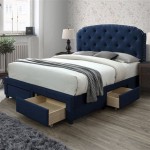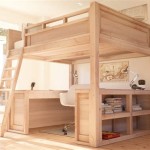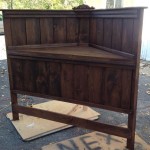DIY Twin Over Queen Bunk Bed Plans
Building a twin-over-queen bunk bed offers a space-saving solution for families and individuals dealing with limited room. This configuration maximizes sleeping capacity while providing a customizable design opportunity. However, careful planning and execution are crucial for ensuring structural integrity and safety. This article will explore key considerations and steps involved in crafting DIY twin-over-queen bunk bed plans.
Understanding the project's scope is the first step. This includes assessing the available space, determining the desired bed height, and researching local building codes. Ceiling height is a critical factor; sufficient clearance is necessary to prevent users of the upper bunk from feeling cramped. Local building codes may dictate specific requirements for guardrails, ladder placement, and overall structural stability.
Material selection is another vital aspect of the planning process. Common choices include lumber like pine, fir, or cedar for their affordability and ease of workability. Hardwoods offer greater durability but come with a higher price tag and can be more challenging to work with. Plywood can also be used for certain components, providing strength and stability. Choosing high-quality lumber, free from knots and warps, is crucial for a robust and long-lasting structure.
Detailed plans are essential for a successful build. Numerous free and paid resources offer pre-designed plans online, offering varying levels of customization. However, creating custom plans allows for specific dimensions and design features tailored to individual needs. If designing custom plans, knowledge of woodworking and structural engineering principles is highly recommended.
Safety features must be integrated into the design from the outset. Guardrails on the upper bunk are non-negotiable, preventing falls during sleep. These should be sufficiently high and securely attached to the bed frame. A sturdy ladder, firmly anchored to the structure, provides safe access to the upper bunk. Consider incorporating non-slip treads on the ladder rungs for enhanced safety.
The building process typically begins with constructing the individual bed frames. This involves cutting the lumber to the desired dimensions according to the plans and assembling the frames using appropriate joinery techniques. Strong joints, such as mortise and tenon or dowel joints, are recommended for enhanced stability. Screws and wood glue further reinforce the structure. Ensuring squareness during assembly is crucial to prevent the final structure from being unstable.
After assembling the individual bed frames, the next step is to connect the twin frame securely above the queen frame. Support posts, positioned at each corner and potentially in the center for added stability, are typically used. These posts should be securely attached to both frames using robust hardware. Cross bracing between the posts further enhances stability, preventing racking or swaying.
Once the basic structure is complete, the focus shifts to installing the safety features. Guardrails are attached to the upper bunk frame, ensuring they are high enough to prevent falls. The ladder is then securely mounted to the structure, providing easy and safe access. Testing the stability of the entire structure throughout the building process is essential.
Finishing touches include sanding all surfaces smooth and applying a protective finish. This could include paint, stain, or a clear sealant. The choice of finish depends on personal preference and the desired aesthetic. Ensure the finish is non-toxic, particularly for children's furniture.
Building a twin-over-queen bunk bed requires careful planning, precise execution, and attention to detail. Prioritizing safety throughout the entire process is paramount. Proper material selection, robust construction techniques, and adherence to safety guidelines contribute to a durable and safe sleeping solution. Thoroughly researching and understanding the project's complexities before commencing construction will significantly increase the likelihood of a successful outcome.
While pre-designed plans offer a convenient starting point, understanding the underlying structural principles allows for customization and adaptation to specific needs. Consulting with experienced woodworkers or structural engineers can provide valuable insights and ensure the final product meets safety standards. Regular maintenance and inspection of the finished bunk bed are essential for ensuring its continued structural integrity and safety over time.
The choice between using metal or wooden connectors and fasteners depends largely on the design and personal preference. Metal connectors offer significant strength and are often easier to use, particularly for beginners. However, wooden joinery techniques, while requiring more skill, can create a more aesthetically pleasing and traditional look. Regardless of the chosen method, ensuring all connections are secure and robust is crucial for the bed's stability.
The height of the lower bunk should also be considered during the design phase. Sufficient clearance beneath the lower bunk allows for storage or even the creation of a cozy play area. This can optimize space utilization, particularly in smaller rooms. Integrating storage solutions into the design, such as drawers beneath the lower bunk or shelves incorporated into the headboard, can further enhance functionality.
Choosing the right mattress is also an important consideration. Ensure the mattresses fit snugly within the frames and are appropriate for the users' age and weight. The thickness of the mattresses, particularly for the upper bunk, will impact the height of the guardrails. This should be factored into the design to maintain adequate safety clearance.

Simple Bunk Bed Plans Twin Over Full Ana White

Modular Bunk Bed Setup Woodworking Blog S Plans How To Diy Cool Beds

Farmhouse Style Twin Over Full Bunk Bed Plans Her Tool Belt

17 Easy Steps For A Diy Built In Bunk Bed Start At Home Decor

Simple Bunk Bed Plans Twin Over Full Ana White

17 Easy Steps For A Diy Built In Bunk Bed Start At Home Decor

Diy Built In Bunk Beds Lauren Koster Creative

Farmhouse Style Twin Over Full Bunk Bed Plans Her Tool Belt

Twin Over Queen Bunk Bed Free Woodworking Plan Com

Diy Build Plans Twin Xl Over Queen Bunk Bed







